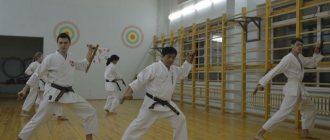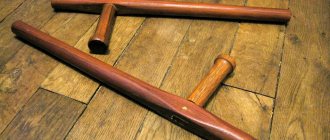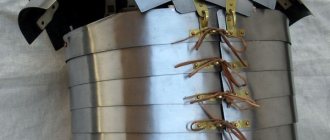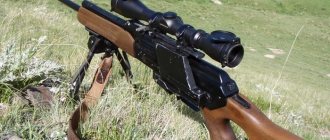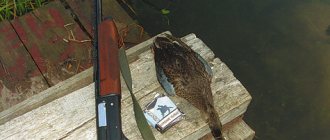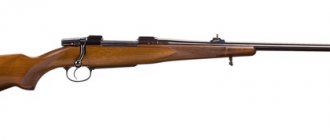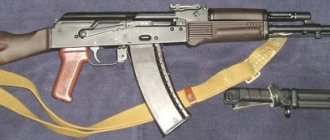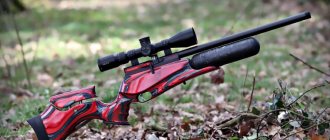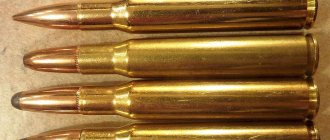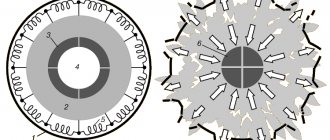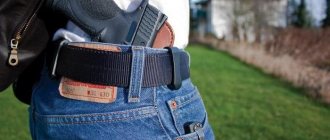It is believed that most types of martial arts came to us from Southeast Asia. We know that there are several dozen schools that pass on the secret of the teachings from generation to generation. Such teachings are more a philosophy of life than a martial art. I have always been amazed by the ability of great masters to arm themselves with improvised objects. We see how in films the main character seems to be juggling with sticks, swords, and knives that come to hand. However, the simplest weapons actually often appeared by chance, from a household item, agricultural tool, or piece of furniture.
A popular weapon today, originally from the island of Okinawa, is Tonfa (tui-fa, tongwa, ton-fa). It is believed that it was not invented as a weapon. This was originally the handle of a small rice mill. In martial arts it is often used in pairs. Democratizers (as police batons were jokingly called) are a practical copy of a tonfa, only the baton that was originally discussed was made of wood.
Time had no power over the tonfa, and over the five hundred years of its existence, it remained virtually unchanged in appearance. Despite the presence of different materials, the weapon itself, as a crutch, remains to be represented.
Tonfa is a weapon with impact and crushing action, consisting of a stick and a perpendicular handle.
History of origin
Tonfa boasts a rather unique history, which is very similar to the history of the creation of the nunchuk. At first, no one even suspected that an ordinary agricultural tool would be in any way involved in martial arts. In the Middle Ages, peasants often had to defend themselves. The most vulnerable class took into service everything that came to hand. Among these things was a mill handle - a tonfa. Later, a whole teaching of martial art was born - kabudo, in which such a simple hand acted as a weapon for self-defense.
After a short time, the popularity of tonfa spread beyond the island of Okinawa. Very soon, terms such as karate, nunchaku, kabudo and tonfa became known throughout Japan. The simplicity of the weapon is deceptive. Despite its trivial design, tui-fa can serve as a universal weapon for offensive and defensive purposes.
The appearance of the tonfa as a weapon dates back to the fifteenth century. There were no strict drawings, as well as dimensions for making the handle. The dimensions were dictated by the size of the fighter's hand. Some historians believe that the stick originally appeared in China, and only then on the island of Okinawa. Its prototype was not the mill handle, but Li Tieguai’s crutch or “lame Li’s crutch.” Law enforcement officers in Japan carried samurai swords.
In Russia, police were also armed with sabers, and police batons appeared in the police only in 1881. In the mid-20th century, Americans patented the Prosecutor PR-24 rubber baton, which was a copy of tonfa, only it was made of rubber and epoxy resin with the addition of aluminum polycarbonates. Lon Anderson himself, the man who patented the police baton, claimed that it had no resemblance to the Japanese tonfa. It was just a broken chair leg with a crossbar. But since the 70s of the 20th century saw the peak of popularity of martial arts and weapons from South Asia, there is no doubt where the roots come from.
The Prosecutor PR-24 baton was manufactured to strict standards. They had a diameter of 3 cm and a length of 60 cm. Its weight varied from 600 to 800 g, since the weapon was made of various materials. The batons entered service with the American army and police in 1974.
The police were enthusiastic about the new type of weapon, because it was possible to control the situation on the streets without using firearms. Skillful actions with the tonfa made it possible not only to beat the criminal, but also to capture him, apply a painful hold, or effectively defend himself.
Summarizing the above, it can be argued that a weapon that is unsightly at first glance has hidden capabilities. A new round of popularity for tonfa came from America. Currently, Russian police are equipped with similar weapons. Our versions – PR-90 and PR-90-M allow you to install an additional aerosol can “Cheryomukha-10”.
WHITE ACACIA (Robinia pseudoacacia) - Locust. It is considered the hardest hardwood in our country. This breed was brought to Europe from North America. Grows in Ukraine, the Caucasus, Crimea and Central Asia. White acacia is a heartwood species with a very narrow yellowish sapwood, sharply demarcated from a greenish-gray or yellowish-gray core. The early zone of the annual layers is occupied by a ring of large vessels. Small vessels in the late zone form groups in the form of dots, dashes or short winding lines; the vessels are clogged with till. The annual layers are clearly visible in all sections. The medullary rays are narrow but noticeable. White acacia wood has a beautiful color and texture, high hardness, strength and resistance to rotting. In terms of physical and mechanical properties, it is significantly higher than oak and ash. The wood does not crack or warp, has great friction resistance, is very elastic and polishes well. In air and under the influence of light, it noticeably darkens over time, making the texture more expressive and brighter. In its homeland, white acacia wood is of great use; In our country it is used in mechanical engineering (wooden screws), for the manufacture of parquet, furniture, and planing tool blocks. Brinell hardness: 7.1.
AMARANTH. ( Peltogyne.) Origin: Central America. Grows in Brazil (Amazon region), Panama, Guiana, Suriname and some other places in South America. The tree is very powerful, reaches a height of 25 m with a trunk thickness of up to 0.8 m. The wood is scattered-vascular, reddish-violet in color with a large expressive texture. In contact with air it becomes darker. Tree rings are clearly visible in the form of dark brown stripes and dashes on a radial section. Hard, dense, but flexible wood. Amaranth is very difficult to saw and varnish. It is used primarily for the production of expensive furniture. Density: 800 - 950 kg/cub.m. Hardness: high, about 5.0.
BEECH - Fagus. Mostly eastern beech (F. orientalis) grows - Oriental beech (in the Caucasus and Crimea), as well as forest beech (F. sylvatica) - European beech. The most favorable conditions for beech growth are mountainous areas containing calcium, with loose and fertile soils. Under optimal conditions, the slow-growing beech reaches a height of 40-45 meters and 150 cm in diameter. The lifespan of beech can reach up to 600 years, but usually 120-year-old trunks have a lot of rot and their wood is of little use. The wood trunks are straight, well-formed, and when growing in forests they can be up to 18 meters in height without knots. When exposed to sunlight, light beech wood darkens. The heart-shaped rays are very wide; when cut, they look like dark shiny spots and give the tree a unique appearance. The wood is light, with a reddish-yellow or grayish honey fungus. It is well processed with cutting tools and polished. Beech reacts quickly to changes in humidity and in this regard is a “capricious” breed. Beech wood lends itself well to special heat treatment, which evens out its color and shifts it towards redder tones (the so-called “smoky beech”). The texture of beech wood is distinguished by its beauty and high decorative qualities, especially in tangential and radial cuts. Beech is not much inferior to oak in strength and hardness, but it is more susceptible to rotting due to its high hygroscopicity. Therefore, beech products cannot be kept in an environment with high humidity. This phenomenon is called “breathing” of wood; to avoid it, the temperature and humidity in the room should not fluctuate within wide limits. The hygroscopicity of beech wood has a positive effect on its finishing and drying. The drying process of wood occurs much faster than with other species, and there are significantly fewer cracks. Beech is easy to split, saw and process with hand tools, and is difficult to polish. Steam-treated beech bends easily; this feature is used in the furniture industry in the manufacture of Viennese chairs. Beech is an excellent material for interior finishing work; it is good for making stair steps, floors, parquet, panels and furniture. Used in wood chemistry. By dry distillation of wood, acetic acid and creosote are obtained. Density: 650 kg/km3. Hardness: 3.8.
Hornbeam - Carpinus betulus, birch family. It is most widespread in Europe, Asia Minor and Iran; it also grows in the Caucasus, the Carpathians, the Crimea, the southwestern and western regions of the CIS. Hornbeam is also called white beech. It has a hard, durable and dense wood with a whitish-gray color. The texture of hornbeam is not bright, like, for example, ash; Light dots are scattered on the evenly matte background of its wood. Often this species has a cross-layered wood structure, so the hornbeam is difficult to split. The sapwood does not make much difference in the transition to the heartwood. To avoid deformation and cracking, it requires long and careful drying. After drying, the hornbeam is almost not subject to warping; its hardness becomes higher than oak. It is difficult to handle with cutting tools. The use of hornbeam in carpentry is varied, although not as widespread as oak, ash or beech; used in mosaic making. The hornbeam is well finished and poisoned. Density: about 750 kg/m3. Hardness: about 3.5.
PEAR - Pirus communis, rose family. Distributed throughout Europe, especially in Central and Southern. It grows wild in the central and southern zones of the European part of Russia, in the Crimea and the Caucasus. A kernel-free species with wood of pinkish-yellowish-white or brownish-red color. In old trees it is usually darker than in young trees. The vessels are very small, the annual layers and medullary rays are barely visible. The wood is dense, hard, easy to process, and rarely cracks. To increase hardness, pear wood is placed in water and kept for a long time, after which it is dried for a long time in the shade. After drying, it acquires a brownish tint. In furniture production, pears are often tinted black. Due to its dense structure, the wood polishes well and provides an excellent material for the smallest carving profiles. When dried, the pear almost does not warp or crack, but is susceptible to wormholes. The texture is thin, the pores and the pattern of annual rings are poorly expressed. Used for making furniture, musical instruments, drawing supplies and other purposes. Density: 700 - 750 kg/m3. Hardness: medium.
OAK - Quercus sp.pl., beech family. The most common is English or summer oak (Q. robur), which occupies 95% of the area of oak forests. Oak, a recognized symbol of eternity, has been used for centuries in the construction industry. Widely distributed in Europe, Asia and America, it is a traditional breed for Russia. Oak grows almost throughout Europe, both in the north and in the south. In Finland, the natural habitat of oak is the Åland Islands and the coastal areas of Southern Finland. Oak also grows in the Caucasus and in some areas of Turkey. Oak easily reaches an age of more than 1000 years. The trees grow up to 18-30 meters and have a diameter of 120-180 cm. The trunk of an oak tree growing in the forest is straight and without knots up to a height of 15 meters. It is distinguished by great variety, because... has a total of about 200 varieties. Northern trees growing in poor soil produce better wood than southern trees. Oak sapwood is light yellow. Mature wood is light brown to yellowish brown with a beautiful texture when cut. It is strong, durable, resistant to external influences. Over time, the oak darkens a little, which gives it a touch of noble antiquity. Oak wood dries relatively slowly, and with accelerated drying it is prone to cracking. To give oak wood higher decorative qualities, it is often stained or etched. By staining oak we mean keeping it in water for many years, from which the wood acquires a silky dark purple color. Staining increases the hardness of the wood, but at the same time increases its fragility. Oak bark and sawdust are used to impregnate other types of wood, which changes their natural color. To do this, wooden blanks are kept in a decoction of a mixture of crushed bark and oak trunk shavings, saturating them with tannins. When choosing a finishing method for an oak product, you need to take into account that this wood does not accept alcohol varnishes and polishes well. The polish is practically not accepted due to its high porosity. The increased hardness of oak wood makes it difficult to drive nails into it and screw in screws. Therefore, it is best to pre-drill to avoid splitting the boards. The oak elements of the staircase stick together well. Oak wood finds a variety of uses: in the form of parquet, sliced veneer for finishing products, in the furniture industry, mechanical engineering, in packaging (barrels for wine and beer) and tanning and extraction industries. Carved massive oak doors coated with transparent weather-resistant varnishes often decorate buildings, especially administrative ones. It is not advisable to paint oak; for this purpose it is necessary to use more accessible wood. When working with oak, it should be taken into account that it is very sensitive to vegetable oil (sunflower, linseed, natural drying oil, etc.) - stains often appear on its surface from the oil. Oak wood must be coated with transparent, quick-drying, weather-resistant varnishes. With wide annual rings, hard and heavy oak is best suited for areas that require a lot of wear resistance. Its wood is suitable for both external and internal use, for example for the manufacture of bridges and piers. With thin annual rings, light and soft oak, good for interior decoration, furniture industry, wood sculpture, turning. Density: on average about 700 kg/m3. Hardness: 3.7 - 3.9.
IRON TREE , or Persian parrotia, (Parrotia persica) - Iron wood. Grows near Lankaran (southern coast of the Caspian Sea). A kernel-free species with wood of a pale pink color, over time it acquires brownish shades. The annual layers are poorly visible. The medullary rays can only be distinguished in a radial section. The wood is very durable and hard, with properties similar to boxwood. Used locally as a construction and ornamental material.
DOGWOOD. It is a tall shrub or tree, sometimes 8 meters high and 50 cm in diameter. Previously, wood was used to make buttons, parts of watch mechanisms, teeth of mill wheels, shuttles of looms, and gun cleaning rods. And arrows and spears made from dogwood wood did not wear out.
RED TREE. The most common and most famous of all tropical trees present on the Russian market. Under the name “mahogany”, various and different-family species are sold that have a common color and, partly, wood structure. They are easy to process, and although they have rather soft wood, they are very popular carpentry materials. The reason for this lies not so much in their remarkable beauty, but in their significant resistance to atmospheric influences and practically unchanged shape and size. When freshly cut, mahogany wood has a yellowish-red color, but over time, under the influence of air and light, it darkens, gradually taking on a brown-red or crimson-red color with clearly visible light and dark veins. There are different types of mahogany: smooth, striped, patterned, flamed, speckled, knotted, etc. The name “mahogany” is often used to designate all so-called red woods. Mahogany and the often used concept of “meranti” are not the same thing. Meranti is a wood from a group of species common in southeast Asia. Application area. High-quality furniture, interior decoration of sailing cabins. In the form of veneer for furniture finishing and parquet production.
MERBAU - (Intsia palembanica). Grows in Southeast Asia (Malaysia, Indonesia, Philippines). An African breed, very similar in properties to the Merbau, is the Doussia. Merbau reaches a height of up to 45 meters and, under favorable growing conditions, the diameter can reach 2 meters. On open surfaces the trunk is short with a branched crown. Trunk up to 15 meters without knots. The main color of merbau is brown, from light to dark brown, interspersed with yellow streaks in places. The wood is very hard, resistant to moisture, and does not dry out much. Thanks to these properties, merbau is used, in particular, for deck construction and interior decoration on ships and yachts. In parquet floors, both in its properties and aesthetically, merbau combines very well with oak. During use, merbau darkens (especially the lighter areas), as a result of which the color of the wood as a whole is evened out. Density: 840 kg/m3. Hardness: 4.1
PADUK (African paduk) - Pterocarpus soyauxii. Grows in Cameroon, Spanish Guinea, Zaire, Nigeria and Angola. Mature wood is coral red, but gradually darkens. The structure of the wood is straight-grained, so it is easy to process. Paduk is very resistant to mechanical loads (pressure) and external influences. Dries easily, but requires slow drying. Density: 750 kg/cub.m. Hardness: 3.8.
ROSEWOOD - Dalbergia latifolia, Dalbergia javanica. Rosewood is the name of different species that have wood similar in color and structure. This name is most often used for the wood of black Dallbergia nigra - Rio rosewood. native to Brazil, and rosewood (D. latifolia) - Indian rosewood (in Southeast Asia). This is a hearty, scattered vascular hardwood with large vessels. The tree is very large, reaching 25m in height and 1.5m in diameter. Sapwood and mature wood are very different. The sapwood is narrow, grayish-white, sometimes with a pinkish tint. Mature wood is very dark (dark brown) with lighter longitudinal veins, and may have a subtle purple or lilac tint. The cut shows the exits of numerous pores (channels) in the form of small black dots or dashes. It is characterized by high hardness and strength, but at the same time it is easy to machine, grind and polish. It is used for the manufacture of valuable musical instruments (pianos), artistic furniture, type-setting parquet, turning products, etc. Drying rosewood involves significant difficulties, because... When this process accelerates, intense cracking occurs. Density: up to 1000 kg/cub.m.
ASH - Fraxinus excelsior, oilseed family. It grows mainly in central Europe, although there are American and Japanese varieties of ash. The most widespread in the middle and southern zone of the European part of the CIS is the common ash (F. excelsior) - European ash; Manchurian ash (F. mandschurica) - Japanese ash (in the Far East). Ash wood is very dense, hard (heavy), sound. The core is light brown, gradually turning into wide yellowish-white sapwood. In the cross section, light continuous wavy lines running along the rings are noticeable. Ash wood is resistant to splitting, but cracks when dried. However, successfully dried ash in crafts is resistant to cracking. It is used primarily in the production of sports equipment, in carpentry, furniture and parquet production in the manufacture of veneer; in car and shipbuilding, as well as in furniture production in the manufacture of veneer. Stair railings and tool handles are made from ash. The bark of a growing ash tree is dark gray, with longitudinal cracks. Characteristic species characteristics of ash: seeds with tongue-shaped wings hang in bunches among the branches, which is especially noticeable with the onset of winter; leaves are imparipinnate with 9-13 oblong leaflets; black buds in winter. It grows in the middle and southern zone of the European part of the CIS, the Caucasus, and Crimea. The best age for use is 80-100 years. Density: on average about 700 kg/cub.m. Hardness: 4.0 - 4.1. Tonfa can also be made from metal.
Jackie Chan with Tonfa in the movie Sity Hunter.
Working with Tonfa.
A selection of films with fights with Tonfa (without sound).
Author
Admin
Tags:
- combat simulators
- solid tonfa weapon
- tonfa
- wood tonfa
- tonfa weapon
- tonfa trainer
Incorrect order of tabs
You do not have sufficient rights to add comments. You need to register on the site.
| Grab Jugs > |
Weapon handling technique
Tonfa allows a fighter to demonstrate a whole series of strikes, blocks and grabs during a fight. The usual grip is made by the transverse handle in such a way that the long end of the tonfa runs along the forearm, and its short end comes out from behind the fist and protrudes forward. With the long end of the stick, a fighter can block almost any enemy blow. The stick protects the forearm even from blows from cold weapons. The same forearm, reinforced with a baton, is used to deliver push and swing blows.
Swing blows can also be applied with the short part of the tonfa, and they will be no less effective. In various martial arts, the baton is used in pairs. They are rotated about an axis passing through the handle, providing a series of whipping or poking blows. The baton technique was developed specifically for police officers. Most of the theoretical material contained ideas about the areas of the human body that need to be influenced. For example, blows to the limbs immobilize a suspect without injuring him. And areas such as the chest and back are central. They can be influenced only in the most urgent cases.
Today there are several modern teachings that discuss in detail the technique of using tonfa. Moreover, these teachings can differ radically from each other. So, we can single out Japanese technology; it is closer to what was studied in Okinawa. In Japanese technique, kata are practiced and the fighter, moving up the ladder of skill, receives colored belts. European schools focus on the practical component of weapons.
Device overview
The ESP company positions the Tonfa 24/59 baton as the fruit of serious research and long-term collaboration between designers and experienced police officers. Accordingly, Tonfa 24/59 is designed to serve not only for household self-defense. Potential users of Tonfa 24/59 are also security officers and police officers.
Tonfa 24/59 is produced by the manufacturer in two varieties. The type of baton is indicated by letter markings:
As can be seen from the table below, the main difference is the ratio between the length of the handle and the working part.
Next, we’ll talk about the size and other characteristics of the Tonfa.
Varieties of baton Tonfa 24/59
Grabs and strikes
If the baton is conditionally divided into three parts, then it will consist of a transverse handle, a longitudinal handle and an impact part. The transverse handle divides the main stick into two parts. The larger one is called the shock part.
There are four basic grips for the tonfa:
- Grab the longitudinal handle. This is the classic holding of a stick in the hand.
- Grab the striking part.
- Grab the cross handle with the longitudinal handle forward.
- Grab the cross handle with the striking part forward.
When holding a baton in a classic manner, a transverse handle is completely unnecessary. This grip is used for sticks that have neither a guard nor a crossbar. The blows are thrown backhand, just as we all chopped nettles with sticks when we were children. To set a block, the grip does not change, that is, the baton in the hand during the block remains in the same position as when striking. Exercises with this grip are reminiscent of fencing.
The grip on the striking part is used very rarely. The fighter must avoid close contact, since it is almost impossible to block with such a grip. But blows delivered with the butt of the side handle can be very painful. Using such a grip, you can hook a running person onto protruding elements of clothing (a strap, a collar). Don't forget about the industrial effect of the baton. By gripping the striking part, you can hammer a nail, split a body, or knock out glass.
The standard grip is considered to be a direct grip on the crossbar, when the striking part of the tonfa is like an extension of the hand, and the longitudinal handle looks forward and protrudes from behind the wrist. With this grip you can perform the following techniques:
- Place a block;
- Make a poke with a crutch (for this you need to apply a regular blow with your hand);
- Strike with the side of your palm, reinforced with a stick.
The reverse side handle grip, with the striking part of the baton facing forward, is used to deliver poke blows over long distances. At the same time, the effectiveness of the swing blow is reduced.
The combat crutch has an average degree of lethality. If it is impossible to guarantee killing a person, then causing him serious harm is quite possible. The main injuries from the use of tonfa are considered to be knocked out teeth, abrasions, and broken limbs. In the Russian Federation, according to the law, tonfa refers to special equipment, but not to weapons. This means that its use is not prohibited, but is associated with a number of certain restrictions, that is, if a person uses a baton in battle, then this fact can be considered as the use of special equipment with the ensuing consequences. However, the use of uncertified batons and homemade products risks the fact that a person will be “taught” to use knives.
Tonfa is often used in martial arts training. It turns out that when practicing techniques, such muscle groups as the muscles of the forearm, biceps, oblique abdominal muscles, triceps, calf muscles, abs, trapezius muscles, and ankle are involved in a complex manner.
Specifications
Data for each baton is in the table below:
| Parameter/type of baton | TF 24/59 | TR 24/59 |
| Length (total), mm | 590 | |
| Longitudinal handle length, mm | 135 | 145 |
| Cross handle length, L/S, mm | 135/120 | |
| Diameter of longitudinal handle, mm | 31 | |
| Cross handle diameter, mm | 28 – 31 | |
| Impact diameter, mm | 32 |
Special mention should be made about the material.
Tonfa in the police
A rubber baton is the most recognizable attribute of a modern police officer, regardless of nationality. In England, police were armed with wooden batons in the 19th century. In Russia, police officers carried sabers, only the lower “class” used batons rather than sabers. In Japan, police officers acquired batons immediately after the First World War. Over time, it was the Japanese police who made adjustments and new techniques to the tonfa technique. Special training manuals were created for law enforcement officers. Until this time, the police were armed with swords. Needless to say, the policeman did not always have the right to use such a formidable weapon?
The Americans patented the rubber baton, which we often see in movies, using the same police officers as an example. But to be fair, there was nothing new in this design, since the stick, both in form and purpose, had long been known. Tonfa PR-73 in Russia is found not only among police officers. Since it is not officially considered a weapon, it is freely used by employees of private security companies (not to be confused with a telescopic baton).
We can say that at present the tonfa is of no interest to collectors of old types of weapons, since in a modern interpretation it is found in real life. Buying a baton is not difficult, but the average person is advised to make sure that the weapon has the necessary certificate.
Analogs
In fact, today Tonfa 24/59 has no complete analogues. There is only a PR-Tonfa brand baton of approximately the same shape. However, unlike Tonfa 24/59, it is made of rubber and is much simpler to perform. But it's cheaper.
Good batons according to consumer reviews:
However, many people still have the question of what is better, tonfa or nunchaku, but this is a personal matter for everyone. You can also make tonfa yourself.
The video below shows how to use a tonfa baton in Asian countries:
Source
Notes
- Liskin Yu. Police baton in Russia // magazine “At a combat post” No. 5-6, 1993
- I. Petrov. Washington Club Bearers // “New Time”, No. 41 of 10/08/1982, p. 17
- Anatoly Fomin. Arsenal: impact weapons // “Brother” magazine, September 2010
- 1 2 Alex Levitas. “This is for you instead of brains...” // Master Gun magazine, No. 65, 2002. pp. 82-85
- Vilis Latsis. Flightless birds. M., “Young Guard”, 1958. pp. 485, 713
- Report of the Minister of Internal Affairs “On arming the lower ranks of the St. Petersburg city police with wooden clubs”
- D. A. Zhukov. I. I. Kovtun. Russian police. M., "Veche", 2010. p.194-197
- V. Prasolov. Rubber stick: practice of use in private security activities // Security Activities magazine, September 2010
- Decree of the Government of the Russian Federation of November 12, 2010 N 894 (as amended on November 24, 2015) “On special means and firearms used by departmental security of the State Cor...
- Official response from the Ministry of Internal Affairs of the Russian Federation.
Rubber baton PR
The rubber baton PR-“Tonfa” with a side handle is intended for employees of private security agencies, representatives of security forces or law enforcement officers.
The length of the rubber baton (stick) is 55 cm, weight 650 grams. Stick diameter 3 cm. Side handle length 10 cm. Side handle diameter 3 cm.
Made in Russia from high quality rubber compound. Transverse elasticity is provided by a 380 mm embedded element.
Our qualified specialists will definitely help you.
We offer truly cheap and convenient delivery options! Our couriers will find you anywhere in Russia. The maximum delivery time is one week for the most remote regions.
Express delivery
Courier delivery covers the entire territory of Russia and the CIS countries.
Delivery in Moscow is carried out for orders over 1000 rubles and for a period of 1-3 days. The cost of delivery in Moscow within the Moscow Ring Road is 350 rubles. Delivery beyond the Moscow Ring Road is 350 rubles + each subsequent kilometer 15 rubles.
In order to find out the cost of delivery to regions of Russia and CIS countries, add the product you like to the cart and indicate the exact address.
Attention!
If you decide to refuse the goods for one reason or another, delivery is still subject to payment.
Mail delivery
Sending by Russian Post is carried out to any region and country of the CIS.
This delivery method is only possible if the total weight of the order does not exceed 20 kg, or it can be divided into several shipments. According to the resolution of the Ministry of Communications of the Russian Federation, Russian Post charges 18% VAT for shipment. This amount is included in the shipping cost.
Parcel machines
Many large shopping centers have parcel terminals - boxes that resemble storage lockers. Detailed instructions will help you pick up your parcel with ease. When ordering, simply select the appropriate delivery method and parcel terminal address - and we will deliver your purchase to the terminal closest to you.
Restrictions for this delivery method
:
Transport companies
You can arrange delivery by a transport company. Choose the one that is in your city and the parcel will arrive at the specified delivery point. Orders are issued on weekdays from 9 a.m. to 6 p.m. only upon presentation of an identification document.
We work with all transport companies and are ready to send goods in a way that is convenient for you; it is also possible to send goods by passing transport. Our specialist will tell you details about the timing, cost and method of delivery.
Order pick-up points
We can deliver your order to any of 2,200 delivery points. When placing an order, select a pickup point convenient for you. To receive the parcel, just provide the order number, which we will send to you via SMS.
Pickup
You can pick up your order yourself. To do this, you need to come to one of our retail stores:
m. "Salaryevo", st. Sholokhov, property 2A.
Pickup hours: daily 09:00-20:00. Tel.
Delivery to other countries
Delivery abroad is carried out by the following services
:
Details of delivery and payment for the order will be clarified by our manager when placing the order. Taxes and duties may be charged by customs in the receiving country.
Attention!
Postal delivery is carried out only with 100% prepayment.
Geography of order delivery
Payment Methods
Paying for our purchases is not only convenient, but also profitable! We provide our regular customers with discounts on all product groups.
Cash payment
You can pay for your purchase in cash in our stores, as well as upon receiving your order from the courier. Upon payment, you will receive all documents confirming the purchase.
Cashless payments
You can pay for goods with a bank card when purchasing in a store. When placing an online order, you can transfer an advance payment to our bank account using the details below.
Name of organization:
Savay LLC
Legal address: 119415, Moscow, Leninsky Ave., 110, building 1, room. II, room I Fact. address: 119634, Moscow, st. Sholokhova, vl. 2A Calc. account 40702810938000190801 PJSC SBERBANK Cor. account 30101810400000000225, BIC 044525225 INN 9729203661, checkpoint 772901001
Here you can receive payment receipts for your order at the Savay store: Receipt form for payment for your Savay store order.
Attention!
Your payment may take up to 3 business days to reach us. We will dispatch the order as soon as we receive confirmation of payment.
